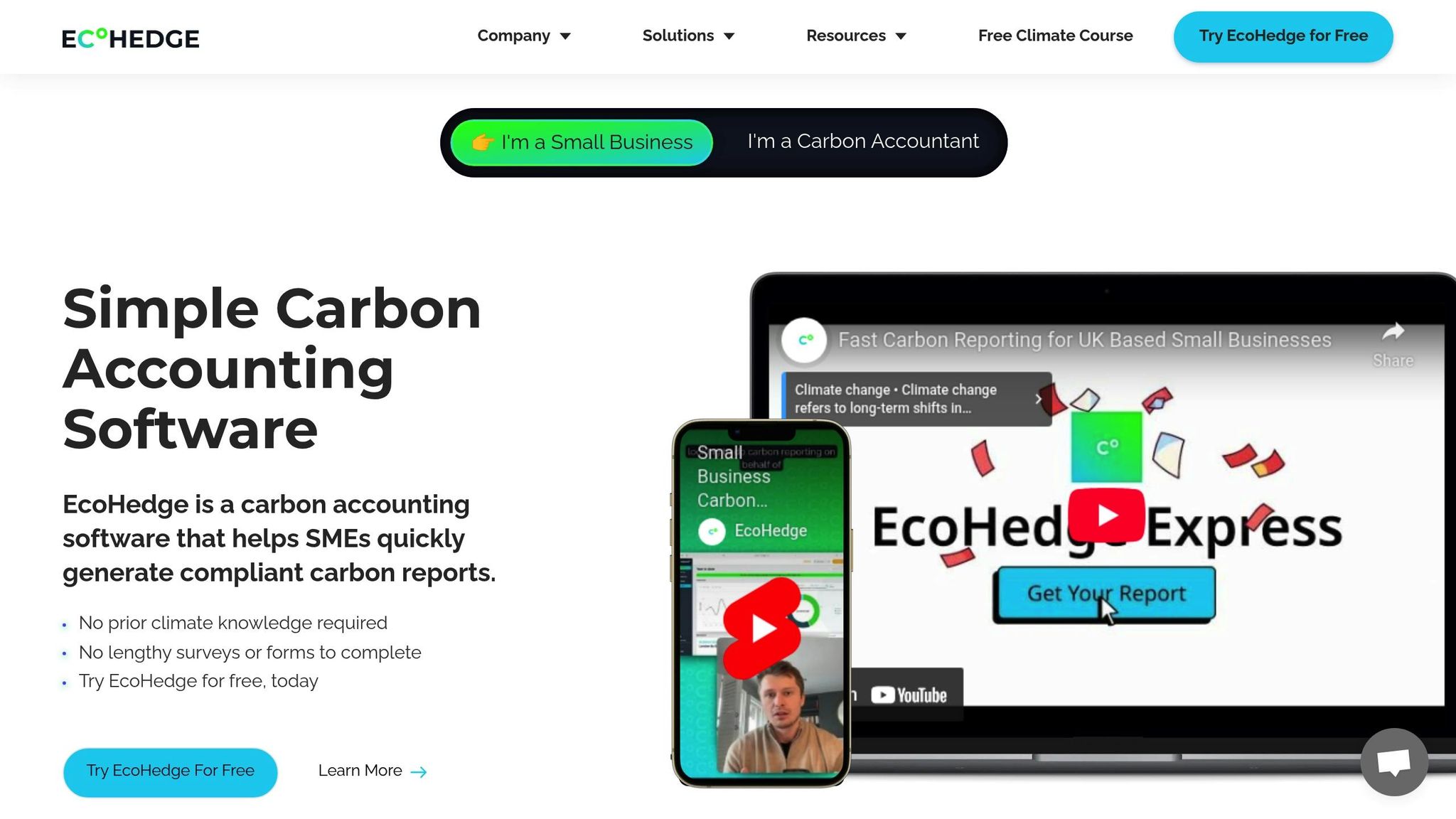Small and medium-sized enterprises (SMEs) are leveraging carbon data to secure contracts in a market increasingly focused on sustainability. Here's why this matters:
- SMEs contribute 63% of business-related emissions across the EU, despite individually emitting far less than large firms.
- Customers, especially larger corporations and public sector buyers, now demand detailed carbon reporting, including Scope 1, 2, and 3 emissions.
- From 2027, listed SMEs in the UK will need to comply with the Corporate Sustainability Reporting Directive (CSRD), but market forces are already pushing non-listed SMEs to follow suit.
Why act now? Early adoption of carbon reporting tools helps SMEs stand out, win contracts, and access green funding. Tools like EcoHedge simplify emissions tracking, making it easier for SMEs to meet buyer expectations and reduce operational costs.
Key takeaways:
- Accurate carbon data is now essential for contract bids.
- Public and private buyers expect reduction plans alongside emissions data.
- Automated tools make reporting accessible, even for resource-limited SMEs.
ESG Challenges & Opportunities for Small Businesses | ESG Pro | #ESG #Sustainability #SmallBusiness
ESG Contract Requirements and Regulatory Drivers
Sustainability has become a core factor in contract negotiations, often determining whether a contract is won or lost. Both market expectations and legal frameworks are pushing for greater transparency in carbon data. For SMEs aiming to stay competitive, understanding these demands is no longer optional - it’s essential. These shifts offer SMEs an opportunity to turn carbon data into a business advantage.
ESG Contract Expectations for SMEs
SMEs now face growing expectations to provide emissions data across three key areas: Scope 1 (direct emissions from operations), Scope 2 (emissions from purchased energy), and Scope 3 (indirect emissions, including those from supply chains, which can account for over 90% of total emissions). Buyers, especially large corporations and public sector entities, are increasingly focused on emissions that extend beyond an SME’s immediate activities, making comprehensive reporting a critical part of contract evaluations.
But it doesn’t stop at reporting emissions. SMEs are also expected to present clear, actionable reduction plans. This includes evidence of engaging with suppliers and demonstrating measurable progress. Public and private sector buyers alike now demand verifiable data across all three scopes - not just baseline figures.
In the public sector, contracts often align with the UK’s net-zero goals, requiring businesses to show how their operations contribute to national climate targets. Private sector buyers, particularly large corporations managing their own ESG risks, may reward suppliers with strong environmental credentials by offering more favourable terms. On the flip side, suppliers who fail to meet these standards risk penalties, including exclusion from procurement processes.
The stakes are high. Falling short of ESG requirements can lead to lost contracts, reduced access to financing, and exclusion from tender opportunities. On the other hand, SMEs that exceed these expectations often enjoy benefits such as access to green financing, improved reputation, and a stronger competitive edge.
Regulations Affecting SME Carbon Reporting
The Corporate Sustainability Reporting Directive (CSRD) is a significant regulatory force shaping carbon reporting for SMEs. From 2027, listed SMEs meeting certain thresholds - 50 or more employees, £6.8 million or more in net turnover, or £3.4 million or more in total assets - will need to report on their carbon data for the 2026 financial year. While there is an option for a two-year delay, many SMEs are opting for early compliance to stay ahead in the market.
Even though non-listed SMEs aren’t legally required to follow the CSRD, market forces are pushing them in that direction. Large corporations, keen to track Scope 3 emissions in their supply chains, are increasingly demanding CSRD-level reporting from their SME partners. This effectively extends the regulation’s influence well beyond its formal scope.
Meanwhile, global standards set by the International Sustainability Standards Board (IFRS S1 and S2) are raising the bar for ESG disclosures. These standards aim to improve consistency and comparability across markets, making it easier for buyers to assess sustainability performance. They require businesses to disclose climate-related risks, governance structures, strategies, risk management processes, and specific metrics and targets.
Even SMEs not directly affected by mandatory reporting are feeling the pressure. Customers, investors, and business partners are now requesting emissions data well before formal compliance deadlines. This reflects a broader trend of prioritising sustainability in decision-making across sectors.
In the UK, national regulations are reinforcing these global and European frameworks. The government’s commitment to achieving net-zero emissions by 2050 has influenced public procurement policies, embedding sustainability criteria into government contracts. For SMEs working with public sector clients, demonstrating robust carbon management practices has become a necessity.
For proactive SMEs, these regulatory trends aren’t just challenges - they’re opportunities. Businesses that adopt carbon reporting standards early are often better placed to adapt to market demands and stakeholder expectations. They can tap into sustainability-linked financing, attract eco-conscious customers, and prepare for future regulatory shifts. By aligning with these requirements, SMEs can strengthen their position in the market and secure valuable ESG-focused contracts.
Case Studies: SMEs Using Carbon Data to Win Contracts
These examples highlight how effective carbon accounting can lead to significant contract wins, showing the practical benefits of adopting thorough carbon tracking and reporting practices.
Case Study 1: Meeting Supply Chain Emissions Targets
A UK-based manufacturing SME faced a challenge when a major retail client began requiring detailed emissions data across all relevant scopes. This demand was part of the retailer's broader ESG commitments, pushing suppliers to provide transparent, verifiable carbon data along with clear plans for reduction.
To meet these requirements, the SME adopted automated carbon accounting software. This technology enabled them to track emissions across all scopes and provide the auditable data their client needed. As a result, the SME retained their contract and was awarded preferred supplier status, leading to a 20% increase in annual orders.
The automated system also provided real-time insights, empowering the SME to make smart decisions about energy use and operational efficiency. These changes not only reduced their carbon footprint but also cut operational costs.
This forward-thinking approach gave the SME a competitive edge. When the retailer later introduced stricter sustainability goals, the SME was already prepared with baseline data and actionable strategies, positioning them as a reliable partner for future collaborations.
Case Study 2: Winning Public Sector ESG Contracts
In the construction industry, a UK SME recognised that public sector contracts were increasingly prioritising sustainability. To remain competitive, they needed to align with the government's net-zero goals and provide detailed environmental impact data.
The SME conducted a full lifecycle analysis, tracking emissions from sourcing materials to final disposal. This detailed approach allowed them to produce comprehensive ESG reports that demonstrated compliance with government carbon reduction targets.
The investment paid off. The SME secured a multi-year contract worth over £500,000, with their transparent carbon data and reduction strategies highlighted as key differentiators. Over the course of the contract, their reporting contributed to a 15% reduction in project-related emissions.
This success had a ripple effect. Other public sector organisations noticed their strong sustainability credentials, leading to invitations to bid on similar contracts. Their reputation as a leader in environmental responsibility became a significant business asset.
How EcoHedge Simplifies Carbon Reporting

These case studies show how automating carbon data management can turn sustainability challenges into business opportunities. Tools like EcoHedge make this process even more accessible for SMEs by streamlining workflows and integrating seamlessly with existing systems like Xero.
For example, a UK SME in the logistics sector used EcoHedge to monitor and reduce fleet emissions, focusing on Scope 1 emissions from their vehicles. The platform's AI-powered automation ensured precise and efficient reporting, saving time while maintaining accuracy.
The results? The SME reported a 15% improvement in contract win rates for tenders that emphasised ESG criteria. By using EcoHedge's GHG Protocol-aligned methodology, they provided clear and credible carbon data, which gave them a competitive edge in procurement processes.
EcoHedge also enables tailored reporting, allowing businesses to create client-specific ESG documents rather than generic sustainability reports. This targeted approach addressed each buyer's unique concerns, further enhancing the SME's appeal.
These examples highlight a consistent trend: SMEs that invest in effective carbon accounting don't just meet compliance standards - they gain a competitive advantage. By combining transparent data, actionable reduction plans, and efficient reporting, these businesses position themselves as ideal partners for organisations prioritising sustainability in both the private and public sectors.
sbb-itb-919600f
Best Practices: Using Carbon Data as a Competitive Advantage
The examples provided show how small and medium-sized enterprises (SMEs) can transform compliance into an edge over competitors. By taking a strategic approach to managing carbon data, SMEs not only strengthen their position in the market but also build more meaningful relationships with clients and partners. These efforts enhance trust while aligning seamlessly with the broader environmental, social, and governance (ESG) strategies discussed earlier.
Building Transparency and Trust with Stakeholders
Transparency is one of the strongest tools in your arsenal when you can deliver clear, verifiable carbon data to clients and partners. Detailed emissions reports foster trust by showing a genuine commitment to sustainability.
Successful SMEs understand the importance of tailoring their carbon reporting to meet specific client needs. As Sam, a user of EcoHedge, explained:
"Tailor reporting to clients that have been really helpful in passing on digestible info and reports on to clients".
This means creating reports that focus on the emissions data most relevant to each client. For manufacturing clients, for instance, it’s essential to highlight Scope 1 and 2 emissions from operations. On the other hand, service-based partnerships may prioritise Scope 3 reduction efforts and how they fit into their sustainability goals.
Keeping accurate, verifiable records is equally important. Using recognised methodologies like the GHG Protocol ensures your data meets the standards required by stakeholders and auditors. Rachel, another EcoHedge user, noted how this level of transparency gave her business "a clear picture of our carbon emissions and can track our progress towards sustainability goals".
Regular updates help maintain trust. Share quarterly reports on emission reductions, energy efficiency efforts, and progress towards net-zero targets. This consistency shows that your environmental commitments go beyond securing contracts and reflect genuine, ongoing improvements.
Aligning with ESG Standards Early
Transparent reporting is just the start. Early adoption of ESG standards can further solidify your position in the market. Starting carbon accounting early not only ensures compliance but also opens up opportunities for green finance. With the Corporate Sustainability Reporting Directive (CSRD) requiring listed SMEs in the EU to start reporting for the 2026 financial year, proactive businesses gain valuable experience while others rush to catch up.
Measuring your complete carbon footprint is crucial. Since 70% of emissions often come from beyond a company’s direct operations, addressing Scope 3 emissions is key to understanding your total environmental impact.
Getting ahead of regulatory changes by implementing carbon reduction plans now can set you apart. When new rules come into effect, you’ll already have the systems and expertise in place. This readiness can be a critical advantage when competing for contracts with organisations that prioritise compliance and risk management.
Using Technology for Efficient and Accurate Reporting
As highlighted in earlier case studies, automation doesn’t just improve accuracy - it also creates opportunities for strategic benefits. Automated tools streamline sustainability reporting. Considering that workers spend nearly half their time preparing data and 80% of that data is unstructured, automation is especially valuable for SMEs with limited resources.
Platforms like EcoHedge simplify the process by integrating with tools SMEs already use, such as Xero and spreadsheets. This eliminates duplicate data entry while ensuring accuracy through AI-driven categorisation and supplier matching.
Technology also delivers actionable insights that guide better decision-making. Automated platforms can pinpoint emission hotspots, compare your performance to industry benchmarks, and suggest specific reduction strategies. These insights allow SMEs to make focused improvements that benefit both the environment and their bottom line.
The importance of accuracy in carbon data cannot be overstated. Manual methods are prone to errors that can damage stakeholder trust and fail to meet regulatory standards. Automated tools, on the other hand, adhere to GHG Protocol methodologies and provide evidence trails that satisfy even the most rigorous audits.
Affordable automation has made accurate carbon accounting accessible to SMEs, levelling the playing field with larger competitors who might otherwise dominate this space.
Collaboration features in these tools also enhance data reliability by enabling teamwork. This ensures the workload is distributed effectively, making comprehensive carbon reporting manageable even for resource-constrained businesses.
Real-time tracking capabilities are another game-changer. Instead of relying on annual assessments, SMEs can monitor their progress continuously. This allows for quick responses to new challenges and provides up-to-date data for client reporting and contract negotiations. When sustainability performance is displayed on a live dashboard rather than in a yearly report, it’s easier to demonstrate how environmental considerations are integrated into daily operations.
Conclusion: The Future of Carbon Data in SME ESG Success
Carbon data has transitioned from being a voluntary effort to a crucial factor in securing ESG contracts. The examples and strategies shared demonstrate how transparent emissions reporting has become a key competitive edge, particularly as large corporations place greater emphasis on supplier sustainability under changing regulations. This trend is shaping a future where evolving rules and technological advancements empower SMEs to take the lead.
Regulatory changes are happening fast. The upcoming CSRD requirements, along with standards like IFRS S1 and IFRS S2, are introducing more stringent disclosure rules that cover all emission scopes. These changes are set to create ripple effects throughout entire supply chains.
While SMEs may have smaller individual emissions, their collective footprint is substantial. This collective impact makes their role critical in achieving global net-zero goals. It also highlights the benefits available to SMEs that act early, including stronger market positioning and enhanced competitiveness.
Digital tools for carbon accounting are levelling the playing field, bringing advanced emissions tracking within reach for SMEs. Platforms like EcoHedge allow businesses to measure their carbon footprint across all scopes with ease, adhering to Greenhouse Gas Protocol standards. These tools automate what used to be a laborious manual process, turning it into an integral part of daily operations. Beyond simplifying compliance, they unlock opportunities for green financing.
Green finance options, such as green loans and sustainability-linked bonds, offer financial incentives to SMEs that can demonstrate clear carbon data and reduction strategies. These benefits include potentially lower interest rates. With investors and lenders increasingly prioritising ESG performance, having reliable emissions data is becoming a strategic advantage for accessing new funding opportunities. SMEs that begin tracking their carbon footprints now can gain a head start, improving their competitive edge and building partnerships with sustainability-focused organisations.
Looking ahead, SMEs that see carbon data not as a regulatory hurdle but as a chance to enhance their brand and market presence will thrive. By adopting strong carbon accounting practices today, they will be better equipped to meet investor demands, customer expectations, and supplier requirements in the future. In a market that values sustainability, credible efforts in this area foster trust, loyalty, and long-term success.
FAQs
How can small and medium-sized enterprises (SMEs) start using carbon reporting tools to meet ESG contract requirements?
Small and medium-sized enterprises (SMEs) aiming to meet ESG (Environmental, Social, and Governance) contract requirements can benefit from using carbon reporting tools. These tools make it easier to track and manage emissions, offering businesses a clear picture of their carbon footprint and highlighting areas where improvements can be made. They also help ensure compliance with sustainability standards.
Automated solutions, like carbon accounting software, are particularly useful. They allow SMEs to report emissions in line with established frameworks such as the Greenhouse Gas Protocol. Beyond aiding progress towards net-zero goals, these tools promote transparency, engage stakeholders, and give SMEs a competitive edge when pursuing ESG-focused contracts.
What financial advantages can SMEs gain by adopting carbon accounting and ESG practices?
Adopting carbon accounting and ESG practices can open up financial opportunities for SMEs. By tracking and reporting their carbon footprint, businesses not only showcase their dedication to sustainability but also ensure compliance with regulations and foster greater transparency with stakeholders.
This forward-thinking approach can boost a company's reputation, making it more attractive to clients, investors, and partners who value environmental responsibility. On top of that, SMEs might find themselves in a better position to win contracts, as many organisations increasingly prefer suppliers with solid ESG credentials.
How can tools like EcoHedge help SMEs simplify ESG reporting and achieve sustainability goals?
EcoHedge offers automated carbon accounting software designed specifically for businesses aiming to achieve net-zero emissions. It provides SMEs with the tools to precisely measure and report their carbon footprint, ensuring they stay aligned with sustainability regulations and industry standards.
The platform takes the complexity out of ESG reporting by tracking emissions across all relevant scopes, as defined by the Greenhouse Gas Protocol. Additionally, it assists businesses in creating emission reduction plans, enabling them to showcase tangible progress to stakeholders and win ESG-focused contracts. By simplifying these critical processes, EcoHedge helps SMEs confidently hit their sustainability goals while staying competitive in the market.



